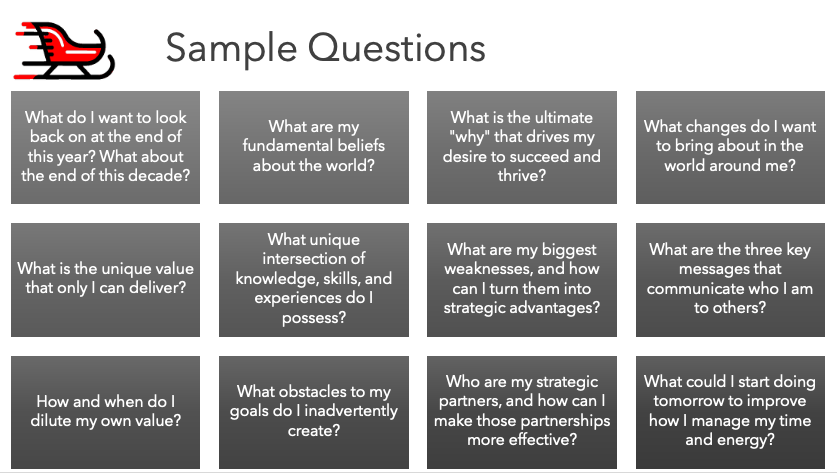Thought leadership should be fun, fast, and fearless. You tap into excitement about new ideas and advocate for something better. That’s the mindset behind The Idea Sled. Projects glide forward gracefully. It’s the momentum of commitment. This newsletter shows you how.
Imagine yourself stepping into a space of strategic solitude, where you deliberately withdraw from the noise and demands of daily life to focus entirely on your own direction and growth. You define the vision. You determine the strategy. You set the goals. You manage finances and talents. You allocate resources. You oversee operations. You market and communicate.
In companies, the people with ultimate accountability for those core activities will get together from time to time for a dedicated retreat. They work together to take inventory of what has gone well and what hasn’t. They collaborate to envision and plan the future. When done well, it’s a powerful mechanism for creating forward momentum.
Like any well-run organization, you perform better when guided by a clear strategy rather than by perpetual reaction to events. Your personal growth and direction deserve the same intentional planning. You can establish strategic solitude by conducting your own executive retreat.
It may seem strange to think of yourself as a collective instead of as a single individual, but in reality, we always wear many hats. We typically switch from role to role over the course of a year, a quarter, and many times, more like several times a week or day. Why not use that splitting to your advantage by being in the room at the same time as all your selves and roles?
Preparing for a Retreat
First, set aside the time. Don’t put this off as something you will do “maybe someday.” Choose a time when you will go offline with minimal interruptions allowed. It works best if you take this as a dedicated day, blocked out on your calendar, with explicit expectations that you won’t be available for the day-to-day. Don’t try to fit this in on a weekend, holiday, or vacation day. It should be a working day entirely dedicated to this purpose.
Do it now! Open your calendar and pick a date within the next four to six weeks.
Second, just as you would for a high-stakes collaborative meeting among peers, set a timed agenda specifying what you will do in each hour of your retreat. As you think about the agenda items, approach them as if you were assigning slots to specific roles within yourself. For example, your visionary self kicks things off with a 30-minute visioning exercise. Your operational self rounds up activities and resources for 60 minutes. Your growth-focused self speaks about talent and skills for 30 minutes. Your communicator self leads a branding exercise for 45 minutes. You have a 30-minute lunch break. Schedule everything.

Third, go back through your agenda and develop two to three hard-hitting questions or topics for each. You know it’s a good question when you don’t immediately have the answer and when asking it makes you feel a bit uncomfortable. It puts you somewhat out on a limb, makes you feel a bit off-balance, maybe even exposed.
One particularly valuable area to explore during your strategic solitude is mapping out the contours of your potential thought leadership. Your personal retreat is the perfect time to step back and identify what you know, what you’ve learned, and what you’ve experienced that others haven’t. People tend to underestimate the distinctive value they bring to the world because they’re too close to see it. You can escape this common flaw by asking: what combination of skills, knowledge, expertise, and experiences do only you possess?
Committing to Your Day
The day before your scheduled day, make sure you can commit to the agenda in full. No, you’re not going to multitask your way through your own strategic solitude retreat. No, you can’t just respond to a few emails. No, you won’t be available on Slack. No, people can’t call or text you unless it’s a genuinely critical emergency.
Then, for the day of your retreat, decide how you will go through your agenda. You have a few options. Since I’m a writer by nature, I prefer just sitting down to a blank page or blank screen and jotting down my thoughts about the question.
Sometimes, I’ll just type down unstructured notes and ideas, but more often, I get better outcomes as if I am answering a serious question from someone I respect (which, of course, I am!) and taking the time to think through and compose my answers in a structured manner.

Another option that works for me sometimes is the “walk and talk.” I put on my headset and speak my thoughts into my phone’s voice recording app, either pacing around indoors or taking it outside for a peaceful, quiet walk in the fresh air. Then I put those files through a transcription app so that I have detailed, easily accessible notes. I use an AI chatbot to help distill and organize them.
Finally, give yourself specific, actionable next steps and follow-up tasks. Document them. If you have research or fact-finding to do, break it into discrete tasks and fold them into your plans for the days and weeks ahead. Block out time on your calendar now for a quarterly review where you can reflect on progress, obstacles, and any needed course corrections. This planning step is also a great fit for generative AI.
Building on Your Foundation
Without taking strategic solitude, you drift. You react instead of respond. You let external demands dictate your direction rather than charting your own course. The noise of daily life drowns out your ability to hear your own voice clearly, blocking you from what you truly want to build, contribute, and become. An entire world of shouting and clicking profits from your distraction.
You can resist the noise and drift by carving out time for deep reflection and intentional planning, laying the foundation for what truly reflects your values, capabilities, and aspirations.





